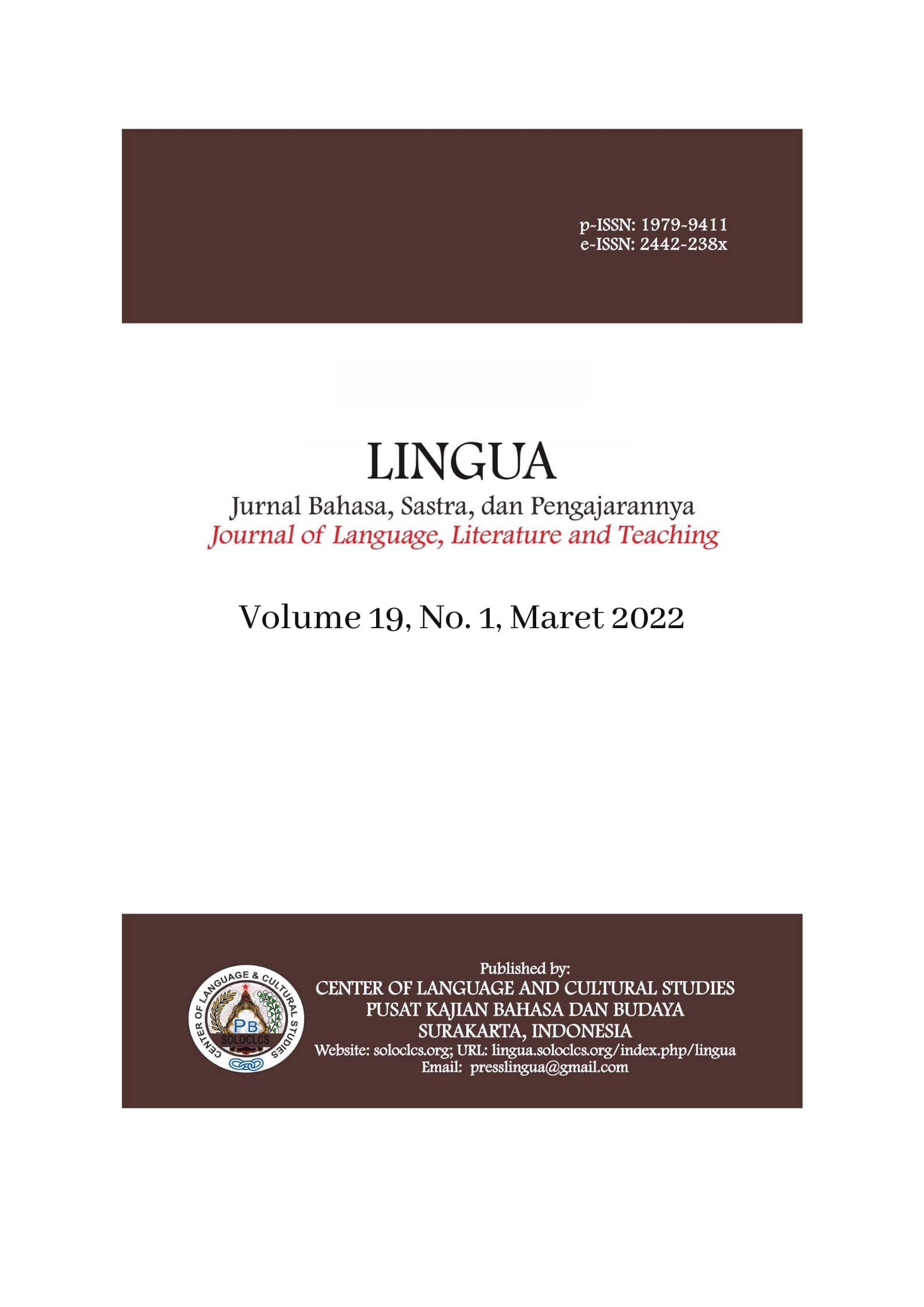HONORIFIK BAHASA JEPANG (KEIGO) DALAM SURAT ELEKTRONIK DI PERUSAHAAN JEPANG
DOI:
https://doi.org/10.30957/lingua.v19i1.661Keywords:
Japanese, keigo, performative honorifics, subject honorifics, object honorifics.Abstract
This research is aimed to describing the honorific terms and their relationship with the users’ social status. This study focuses on the use of Japanese honorific forms used on emails by the employees in a Japanese company. The method of this research is qualitative-based procedure consisting the techniques of collecting data and the steps of analyzing data. The data are collected from the emails sent and received by Japanese employers and employees in the company confidentially. The relationships between the forms and the social status of the users are identified based on Harada’s theory. As a result, this research proves that the honorific address term sama is used to address socially lower receiver than the sender. Other forms of honorifics found in this study are the performative honorific. It is the dominant type of honorific on the emails. This honorific is used to address the receiver with higher and lower social status than the sender. This research shows that the social status in a working environment is not an absolute factor in the use of honorifics.
Downloads
References
Bunt, Jonathan. (2003). Oxford Japanese Grammar and Verbs. New York: Oxford University Press Inc.
Harada, S.I. (1976). Honorifics. New York: Academic Press.
Hidayatullah, M. Fajri dan Dedi Rahman Nur. (2019). “An Analysis of Imperative Sentence in “Uang Panai†Movieâ€. Jurnal IJOTL-TL 4 (3): 187-198.
Holmes, Janet. (2013). An Introduction to Sociolinguistics (Ed. Keempat). New York: Routledge Taylor and Francis Group.
Kolobe, Dr. ‘Maboleba dan Dr. Madira ‘Thetso. (2019). “Language Use by Tertiary Students: The Case of The National University of Lesothoâ€. Jurnal Lingua 16 (2): 157-174.
Miles, M.B. dan Huberman, A.M. (1994). Qualitatif Data Analisis: An Expanded Sourcebook Second Edition. London: Sage Publications
Ide, Sachiko. (1982). “Japanese Sociolinguistics Politeness an Women’s Languageâ€. Jurnal Lingua 57:357-385.
Mileh, I Nengah. (2020). “Makna Bahasa Tubuh: Suatu Kajian Lintas Budayaâ€. Jurnal KULTURISTIK 4 (2): 37-43.
Ogawa, Yoshio. (1982). Nihongo Kyoiku Jiten. Tokyo: Daiosamu Toshokan.
Pratiwi, Dyah Martanti Indah. (2020). “Pemakaian Kata Sapaan (Taishoushi) di Dunia Kerja Perhotelan: Analisis Percakapan Drama TV dan Film Jepangâ€. Jurnal Lingua Applicata 3 (2): 104-121.
Priska, Ni Putu Diah, dkk. (2020). “The Types of Woman Language Features Found in The Fault in Our Stars Movieâ€. Jurnal Lingual 9 (1): 27-33.
Sari, Aisya Novita. (2020). “An Analysis of Translation Strategies of Honorific Term in the Film “The Boss Babyâ€â€. Jurnal Indonesian Journal of EFL and Linguistics 5 (2): 355-372.
Susylowati, Eka. (2020). “Bentuk Kata Sapaan dalam Bahasa Jawa di Kraton Surakarta Hadiningrat (Kajian Sosiolinguistik)â€. Jurnal SPHOTA 12 (1): 34-42.
Syahriy, Nurul Nisfu, dkk. (2020). “The Phenomenon of Language Games as College Students Responses to The Revised Criminal Code Draft 2019: A Sociolinguistics Studyâ€. Jurnal JOALL 5 (2): 123-136.
Yoshiko, Okushi. (1998). “Use of Japanese Honorifics in Daily Life: What the Traditional Theories Do Not Sayâ€. Jurnal the Annual Meeting of the American Association for Applied Linguistics 42:1-10.
Zdenek, Salzmann. (1998). Language, Culture, and Society: An Introduction to Linguistic Anthropology. USA: Westview Press.
Downloads
Published
How to Cite
Issue
Section
License
Authors who publish with this journal agree to the following terms:
- Authors retain copyright and grant the journal right of first publication with the work simultaneously licensed under a Creative Commons Attribution-ShareAlike 4.0 International License that allows others to share the work with an acknowledgement of the work's authorship and initial publication in this journal.
- Authors are able to enter into separate, additional contractual arrangements for the non-exclusive distribution of the journal's published version of the work (e.g., post it to an institutional repository or publish it in a book), with an acknowledgement of its initial publication in this journal.
- Authors are permitted and encouraged to post their work online (e.g., in institutional repositories or on their website) prior to and during the submission process, as it can lead to productive exchanges, as well as earlier and greater citation of published work (See The Effect of Open Access).















